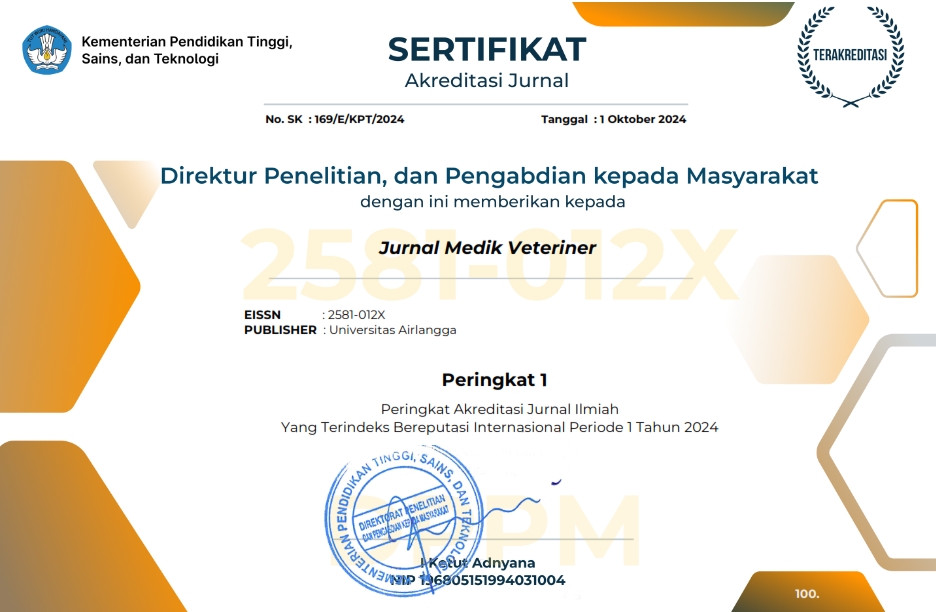Contaminants and Human Health Risks Associated with Exposure to Microplastic Ingestion of Green Mussels (Perna viridis) Collected from The Kedonganan Fish Market, Bali

Downloads
Microplastics (MPs) are pollutant agents that have been absorbed and detected in aquatic ecosystems at high concentrations. This study aimed to investigate the presence of MPs pollution in green mussel (Perna viridis) products sold at the Kedonganan fish market, Badung, Bali. A total of 150 mussels with an average weight of 3,2 ± 0,71 g/mussels from three traders each composed and followed by the pre-treatment stage using 5 M NaCl solution, extraction with wet oxidation peroxidation (WPO) + Fe(II) catalyst and filtered. The highest percentage for the form of MPs was successively obtained by the Line form in Trader A at 85,42% and the lowest in Trader C at 50,00%. The highest form of fragments was obtained in Trader C at 42,86%. Film and filament forms were only obtained in Trader A. The highest MPs color was black and the lowest was gray. The highest average MPs particle size was found in the form of a filament of 1944,37 ± 88,41 μm which was found in Trader A. Estimates of MPs intake per year/capita in Indonesia showed that exposure to MPs through consumption of green mussels in this study amounted to 498,330 MPs/year/capita items. Overall, the green mussel from Trader A had the highest percentage and size of MPs, with the shape of fragment MPs being dominated by Trader C and the color of the MPs being dominated by black. MPs exposure to green mussel consumption in Indonesia is very high, but no health impact category has yet been found for this estimate.
Akhbarizadeh, R., Moore, F., & Keshavarzi, B. (2018). Investigating a probable relationship between microplastics and potentially toxic elements in fish muscles from northeast of Persian Gulf. Environmental Pollution, 232, 154–163.
Barboza, L. G. A., Lopes, C., Oliveira, P., Bessa, F., Otero, V., Henriques, B., Raimundo, J., Caetano, M., Vale, C., & Guilhermino, L. (2020). Microplastics in wild fish from North East Atlantic Ocean and its potential for causing neurotoxic effects, lipid oxidative damage, and human health risks associated with ingestion exposure. Science of The Total Environment, 717, 134625.
Bertrand, L., Monferrán, M. V., Mouneyrac, C., & Amé, M. V. (2018). Native crustacean species as a bioindicator of freshwater ecosystem pollution: A multivariate and integrative study of multi-biomarker response in active river monitoring. Chemosphere, 206, 265–277.
Bhatt, P., Pathak, V. M., Bagheri, A. R., & Bilal, M. (2021). Microplastic contaminants in the aqueous environment, fate, toxicity consequences, and remediation strategies. Environmental Research, 200, 111762.
Bhuyan, M. S. (2022). Effects of Microplastics on Fish and in Human Health. Frontiers in Environmental Science, 10.
Boerger, C. M., Lattin, G. L., Moore, S. L., & Moore, C. J. (2010). Plastic ingestion by planktivorous fishes in the North Pacific Central Gyre. Marine Pollution Bulletin, 60(12), 2275–2278.
Catarino, A. I., Macchia, V., Sanderson, W. G., Thompson, R. C., & Henry, T. B. (2018). Low levels of microplastics (MP) in wild mussels indicate that MP ingestion by humans is minimal compared to exposure via household fibres fallout during a meal. Environmental Pollution, 237, 675–684.
Cox, K. D., Covernton, G. A., Davies, H. L., Dower, J. F., Juanes, F., & Dudas, S. E. (2019). Human Consumption of Microplastics. Environmental Science & Technology, 53(12), 7068–7074.
Dawson, A. L., Li, J. Y. Q., & Kroon, F. J. (2022). Plastics for dinner: Store-bought seafood, but not wild-caught from the Great Barrier Reef, as a source of microplastics to human consumers. Environmental Advances, 8, 100249.
Desforges, J.-P. W., Galbraith, M., & Ross, P. S. (2015). Ingestion of Microplastics by Zooplankton in the Northeast Pacific Ocean. Archives of Environmental Contamination and Toxicology, 69(3), 320–330.
EFSA. (2016). Presence of microplastics and nanoplastics in food, with particular focus on seafood. EFSA Journal, 14(6).
Fok, L., Cheung, P. K., Tang, G., & Li, W. C. (2017). Size distribution of stranded small plastic debris on the coast of Guangdong, South China. Environmental Pollution, 220, 407–412.
Grbin, D., Sabolić, I., KlobuÄar, G., Dennis, S. R., Å rut, M., Bakarić, R., Baković, V., Brkanac, S. R., Nosil, P., & Å tambuk, A. (2019). Biomarker response of Mediterranean mussels Mytilus galloprovincialis regarding environmental conditions, pollution impact and seasonal effects. Science of The Total Environment, 694, 133470.
Hao, Y., Sun, H., Zeng, X., Dong, G., Kronzucker, H. J., Min, J., Xia, C., Lam, S. S., & Shi, W. (2023). Smallholder vegetable farming produces more soil microplastics pollution than large-scale farming. Environmental Pollution, 317, 120805.
Hartmann, N. B., Hüffer, T., Thompson, R. C., Hassellöv, M., Verschoor, A., Daugaard, A. E., Rist, S., Karlsson, T., Brennholt, N., Cole, M., Herrling, M. P., Hess, M. C., Ivleva, N. P., Lusher, A. L., & Wagner, M. (2019). Are We Speaking the Same Language? Recommendations for a Definition and Categorization Framework for Plastic Debris. Environmental Science & Technology, 53(3), 1039–1047.
Imasha, H. U. E., & Babel, S. (2021). Microplastics Contamination in Commercial Green Mussels from Selected Wet Markets in Thailand. Archives of Environmental Contamination and Toxicology, 81(3), 449–459.
Joyce, P. W. S., & Falkenberg, L. J. (2023). Microplastic abundances in co-occurring marine mussels: species and spatial differences. Regional Studies in Marine Science, 57, 102730.
Kedzierski, M., Lechat, B., Sire, O., Le Maguer, G., Le Tilly, V., & Bruzaud, S. (2020). Microplastic contamination of packaged meat: Occurrence and associated risks. Food Packaging and Shelf Life, 24, 100489.
Khoironi, A., Anggoro, S., & Sudarno. (2018). The existence of microplastic in Asian green mussels. IOP Conference Series: Earth and Environmental Science, 131, 012050.
Kiran, B. R., Kopperi, H., & Venkata Mohan, S. (2022). Micro/nano-plastics occurrence, identification, risk analysis and mitigation: challenges and perspectives. Reviews in Environmental Science and Bio/Technology, 21(1), 169–203.
Kögel, T., Bjorí¸y, í˜., Toto, B., Bienfait, A. M., & Sanden, M. (2020). Micro- and nanoplastic toxicity on aquatic life: Determining factors. Science of The Total Environment, 709, 136050.
Kowalski, N., Reichardt, A. M., & Waniek, J. J. (2016). Sinking rates of microplastics and potential implications of their alteration by physical, biological, and chemical factors. Marine Pollution Bulletin, 109(1), 310–319.
Lambert, S., Scherer, C., & Wagner, M. (2017). Ecotoxicity testing of microplastics: Considering the heterogeneity of physicochemical properties. Integrated Environmental Assessment and Management, 13(3), 470–475.
Lehtiniemi, M., Hartikainen, S., Näkki, P., Engström-Öst, J., Koistinen, A., & Setälä, O. (2018). Size matters more than shape: Ingestion of primary and secondary microplastics by small predators. Food Webs, 17, e00097.
Mahu, E., Datsomor, W. G., Folorunsho, R., Fisayo, J., Crane, R., Marchant, R., Montford, J., Boateng, M. C., Edusei Oti, M., Oguguah, M. N., & Gordon, C. (2023). Human health risk and food safety implications of microplastic consumption by fish from coastal waters of the eastern equatorial Atlantic Ocean. Food Control, 145, 109503.
Marques, F., Vale, C., Rudnitskaya, A., Moreirinha, C., Costa, S. T., & Botelho, M. J. (2021). Major characteristics of microplastics in mussels from the Portuguese coast. Environmental Research, 197, 110993.
Murray, A., & Örmeci, B. (2020). Removal Effectiveness of Nanoplastics (<400 nm) with Separation Processes Used for Water and Wastewater Treatment. Water, 12(3), 635.
Naidu, B. C., Xavier, K. A. M., Shukla, S. P., Jaiswar, A. K., & Nayak, B. B. (2022). Comparative study on the microplastics abundance, characteristics, and possible sources in yellow clams of different demographic regions of the northwest coast of India. Journal of Hazardous Materials Letters, 3, 100051.
Nelms, S. E., Barnett, J., Brownlow, A., Davison, N. J., Deaville, R., Galloway, T. S., Lindeque, P. K., Santillo, D., & Godley, B. J. (2019). Microplastics in marine mammals stranded around the British coast: ubiquitous but transitory? Scientific Reports, 9(1), 1075.
Okamoto, K., Nomura, M., Horie, Y., & Okamura, H. (2022). Color preferences and gastrointestinal-tract retention times of microplastics by freshwater and marine fishes. Environmental Pollution, 304, 119253.
Okocha, R. C., Olatoye, I. O., & Adedeji, O. B. (2018). Food safety impacts of antimicrobial use and their residues in aquaculture. Public Health Reviews, 39(1), 21.
Olsvik, P. A., Larsen, A. K., Berntssen, M. H. G., Goksí¸yr, A., Karlsen, O. A., Yadetie, F., Sanden, M., & Kristensen, T. (2019). Effects of Agricultural Pesticides in Aquafeeds on Wild Fish Feeding on Leftover Pellets Near Fish Farms. Frontiers in Genetics, 10.
Ory, N., Chagnon, C., Felix, F., Fernández, C., Ferreira, J. L., Gallardo, C., Garcés Ordóñez, O., Henostroza, A., Laaz, E., Mizraji, R., Mojica, H., Murillo Haro, V., Ossa Medina, L., Preciado, M., Sobral, P., Urbina, M. A., & Thiel, M. (2018). Low prevalence of microplastic contamination in planktivorous fish species from the southeast Pacific Ocean. Marine Pollution Bulletin, 127, 211–216.
Pinto-Poblete, A., Retamal-Salgado, J., Zapata, N., Sierra-Almeida, A., & Schoebitz, M. (2023). Impact of polyethylene microplastics and copper nanoparticles: Responses of soil microbiological properties and strawberry growth. Applied Soil Ecology, 184, 104773.
Prata, J. C. (2018). Airborne microplastics: Consequences to human health? Environmental Pollution, 234, 115–126.
Pratiwi, M. A., Ernawati, N. M., & Wijayanti, N. P. P. (2020). Penilaian Status Sumberdaya Ikan Hasil Tangkapan Dominan yang Didaratkan di PPI Kedonganan dengan Pendekatan Multi-Criteria Analysis (MCA). Journal of Marine and Aquatic Sciences, 6(2), 152–160.
Richard, F.-J., Southern, I., Gigauri, M., Bellini, G., Rojas, O., & Runde, A. (2021). Warning on nine pollutants and their effects on avian communities. Global Ecology and Conservation, 32, e01898.
Rist, S., Carney Almroth, B., Hartmann, N. B., & Karlsson, T. M. (2018). A critical perspective on early communications concerning human health aspects of microplastics. Science of The Total Environment, 626, 720–726.
Rochman, C. M., Brookson, C., Bikker, J., Djuric, N., Earn, A., Bucci, K., Athey, S., Huntington, A., McIlwraith, H., Munno, K., De Frond, H., Kolomijeca, A., Erdle, L., Grbic, J., Bayoumi, M., Borrelle, S. B., Wu, T., Santoro, S., Werbowski, L. M., Hung, C. (2019). Rethinking microplastics as a diverse contaminant suite. Environmental Toxicology and Chemistry, 38(4), 703–711.
Rosiana, I. W., Wiradana, P. A., Permatasari, A. A. A. P., Pelupessy, Y. A. E. G., Dame, M. V. O., Soegianto, A., Yulianto, B., & Widhiantara, I. G. (2022). Concentrations of Heavy Metals in Three Brown Seaweed (Phaeophyta: Phaeophyceae) Collected from Tourism Area in Sanur Beach, Coast of Denpasar, Bali and Public Health Risk Assessment. Jurnal Ilmiah Perikanan Dan Kelautan, 14(2), 327–339.
Scott, N., Porter, A., Santillo, D., Simpson, H., Lloyd-Williams, S., & Lewis, C. (2019). Particle characteristics of microplastics contaminating the mussel Mytilus edulis and their surrounding environments. Marine Pollution Bulletin, 146, 125–133.
Sendra, M., Sparaventi, E., Novoa, B., & Figueras, A. (2021). An overview of the internalization and effects of microplastics and nanoplastics as pollutants of emerging concern in bivalves. Science of The Total Environment, 753, 142024.
Simon-Sánchez, L., Grelaud, M., Garcia-Orellana, J., & Ziveri, P. (2019). River Deltas as hotspots of microplastic accumulation: The case study of the Ebro River (NW Mediterranean). Science of The Total Environment, 687, 1186–1196.
Smith, M., Love, D. C., Rochman, C. M., & Neff, R. A. (2018). Microplastics in Seafood and the Implications for Human Health. Current Environmental Health Reports, 5(3), 375–386.
Suariningsih, K. T., Restu, I. W., & Pratiwi, M. A. (2021). Penilaian Status Domain Sumber Daya Ikan Lemuru dengan Pendekatan Ekosistem yang didaratkan di PPI Kedonganan, Bali. ECOTROPHIC : Jurnal Ilmu Lingkungan (Journal of Environmental Science), 15(2), 236.
Sultan, M. B., Rahman, M. M., Khatun, M. A., Shahjalal, M., Akbor, M. A., Siddique, M. A. B., Huque, R., & Malafaia, G. (2023). Microplastics in different fish and shellfish species in the mangrove estuary of Bangladesh and evaluation of human exposure. Science of The Total Environment, 858, 159754.
Tian, L., Ma, L. Y., Chen, X., Ge, J., Ma, Y., Ji, R., & Yu, X. (2023). Insights into the accumulation, distribution and toxicity of pyrene associated with microplastics in rice (Oryza sativa L.) seedlings. Chemosphere, 311, 136988.
Walkinshaw, C., Lindeque, P. K., Thompson, R., Tolhurst, T., & Cole, M. (2020). Microplastics and seafood: lower trophic organisms at highest risk of contamination. Ecotoxicology and Environmental Safety, 190, 110066.
Wasilah, Q. A., Mawli, R. E., Sani, M. D., Soegianto, A., Wiradana, P. A., & Pradisty, N. A. (2021). Determination of Lead and Cadmium in Edible Wedge Clam (Donax faba) Collected from North and South Coasts of Sumenep, East Java, Indonesia. Pollution Research, 40(2), 593–597.
Wiradana, P. A., Soegianto, A., Nege, A. S., & Naw, S. W. (2020). Pathogenic food-borne bacteria in Shellfish and shrimp from the largest traditional seafood market in Surabaya, Indonesia. Ecology, Environment and Conservation, 26(April Supplementary Issue), 1–6.
Wiradana, P. A., Yusup, D. S., & Soegianto, A. (2019). Biomonitoring Escherichia coli and Coliform Contamination in Abalone (Haliotis squamata) Cultivation Pond in Musi Village, Gerokgak Sub-District, Buleleng-Bali. Aquacultura Indonesiana, 20(1), 32.
Xiong, X., Tu, Y., Chen, X., Jiang, X., Shi, H., Wu, C., & Elser, J. J. (2019). Ingestion and egestion of polyethylene microplastics by goldfish (Carassius auratus): influence of color and morphological features. Heliyon, 5(12), e03063.
Yona, D., Samantha, C. D., & Kasitowati, R. D. (2021). Perbandingan Kandungan Mikroplastik pada Kerang Darah dan Kerang Tahu dari Perairan Desa Banyuurip, Gresik. Saintek Perikanan : Indonesian Journal of Fisheries Science and Technology, 17(2), 108–114.
Yuan, Z., Nag, R., & Cummins, E. (2022). Human health concerns regarding microplastics in the aquatic environment - From marine to food systems. Science of The Total Environment, 823, 153730.
Yunanto, A., Sarasita, D., & Yona, D. (2021). Analisis Mikroplastik Pada Kerang Kijing (Pilsbryoconcha exilis) Di Sungai Perancak, Jembrana, Bali. Journal of Fisheries and Marine Research, 5(2), 445–451.
Zhang, K., Liang, J., Liu, T., Li, Q., Zhu, M., Zheng, S., & Sun, X. (2022). Abundance and characteristics of microplastics in shellfish from Jiaozhou Bay, China. Journal of Oceanology and Limnology, 40(1), 163–172.
Zhang, Q., Xu, E. G., Li, J., Chen, Q., Ma, L., Zeng, E. Y., & Shi, H. (2020). A Review of Microplastics in Table Salt, Drinking Water, and Air: Direct Human Exposure. Environmental Science & Technology, 54(7), 3740–3751.
Copyright (c) 2023 Putu Angga Wiradana, I Made Gde Sudyadnyana Sandhika, I Gede Widhiantara, Aimatun Nisfia Rizqy, Agoes Soegianto, Bambang Yulianto

This work is licensed under a Creative Commons Attribution-NonCommercial-ShareAlike 4.0 International License.
Authors who publish in this journal agree to the following terms:
1. The journal allows the author to hold the copyright of the article without restrictions;
2. The journal allows the author(s) to retain publishing rights without restrictions;
3. The legal formal aspect of journal publication accessibility refers to Creative Commons Attribution-NonCommercial-ShareAlike 4.0 International License (CC BY-NC-SA).






11.jpg)




















